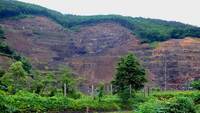- England
- Scotland
- France
- Holland
- Germany
- Italy
- Spain
- Portugal
- USA
- China
- Japan
- India
- Iran
- Advice
- Gardens
- England
- Scotland
- France
- Holland
- Germany
- Italy
- Spain
- Portugal
- USA
- China
- Japan
- India
- Iran
- Advice
- Garden Tours
Book: Landscape Planning and Environmental Impact Design: from EIA to EID
Chapter: Chapter 6 Mineral working, planning and design
The innovative approach to the landscape of minerals is founded on the recognition that there are many occasions on which it is not feasible or appropriate to return land to its initial condition. Highwalls, cliffs and lakes can be appreciated. In America a committee of the National Academy of Sciences proposed the not altogether satisfactory word 'rehabilitation' to describe the innovative approach. They said that rehabilitation implies 'the land will be returned to a form and productivity in conformity with a prior land use plan including a stable ecological state' (Study Committee on the Potential for Rehabilitating Lands 1974: 11). It is a most important concept. Many old mineral workings, and especially those which date from the days of the pick axe and the pack horse, have created a fascinating landscape which planning authorities now wish to retain. The Lake District National Park Plan states that the public have 'indicated a strong concern for most derelict sites to be left alone, as they form part of the landscape character giving interest and variety' (Lake District Special Planning Board 1978: 173). Old quarries are of particular interest to industrial archaeologists and geologists. The Planning board is however 'against further large scale aggregate working in the National Park and any new quarry or extension to an existing quarry will be severely restricted' (Lake District Special Planning Board 1973: 172). They will not risk the creation of new landscapes because of the grim reputation of modern quarrying. Yet an innovative approach is the only alternative for many types of operation. In 1972 a Commission on Mining and the Environment stated that: Where existing landforms have been substantially altered, it would not be sensible to talk of "restoration". Advantage would need to be taken of the opportunity to create new forms and patterns, and even planning for new land uses, within the general policy for the area' (Commission on Mining and the Environment, 1972). The concept of automatic 'backï¾toï¾contour' restoration has also been criticised in America. Environmentalists have pressed for the Appalachian strip mines to be restored in this way. They point out that: 'where hilly or mountainous land is mined using the contour technique, the result is long sinuous slashes winding around the sides of hills and valleys. The highwall rises at a steep gradient above the ruined area, which may contain impounded water, while below lies a landslideï¾prone slope of tree stumps and mud' (Coal surface mining commission 1979: 294). Backï¾toï¾contour restoration is very expensive, unless it is combined with the mining operation, and the restored land may not have any agricultural value. A landscape planner has argued that its justification depends 'on emotion, not sound data' (Simpson 1985). He quotes the evidence which the Chairman of the Tennessee Valley Authority gave to a Senate Committee: One thing Senator, about a highwall, if you leave a highwall, you also leave a fairly wide, level bench, and in many of these mountain areas level land is at a premium. It can be used in the future. Haul roads can be used to get timber out, access for hunting or hiking or fishing, and in some areas close to a town, of course, it has a higher use, housing developments, schools, airplane landing strips, and so on. The erosion and water pollution caused by these old mines is tragic. But as topographic features they have a visual interest and power equal to the British waste tips which have been described as 'splendid spoil heaps' (Barr 1969: 24). The issue of Landscape Architecture in which the above quotation appears also carries an account of a small disused quarry which has been made into a sculpture garden. The artist worked on the quarry for over 20 years before he recognised that the quarry itself had become a work of art. He then 'removed all his other works from the quarry' so that its spatial qualities were displayed (Dalton 1985). The four policies for the landscape of industry can also be applied to any industrial plant which adjoins a mineral operation. Zoning and concealment are possible when a new works is built in an older quarry. If a large hole is available, the plant can be hidden. A conservation approach to architectural design is often chosen as a second best to concealment. The following quotation describes the policy which was adopted for the tailings plant at Boulby potash mine on the East Coast of England: The buildings were designed to make use of natural local materials so that they would become an extension of the existing scene. The structures have walls of natural stone with slate roofs. The main building houses the shaft headgear, hoist and ventilation fans, but there are no outward signs of these, the appearance being of a farm building (Cleasby 1974: 20). When buildings cannot be camouflaged the planner must choose between designing them 'as unobtrusively as possible', as was done for the main treatment plant at Boulby (Cleasby 1974: 17), and an innovative approach. The manufacturing plant at Hope Cement Works is seen by Jellicoe as 'complex geometry drawing upon the laws of the universe' (Jellicoe 1979).
